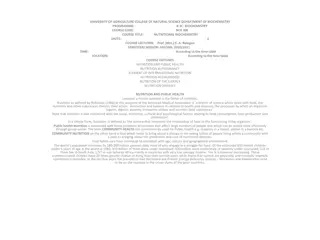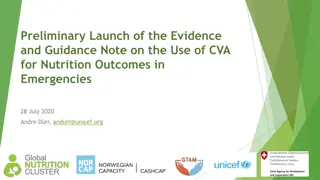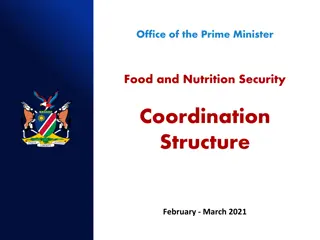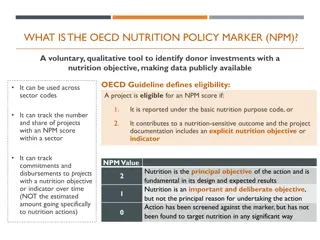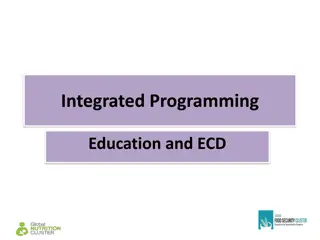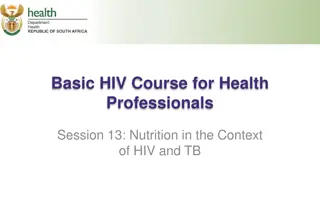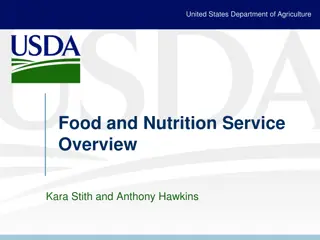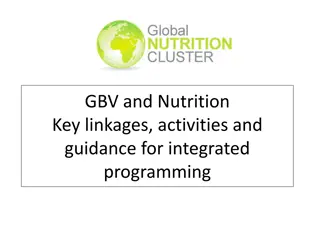Improving Nutrition Goals for Children with CF
Optimizing growth and weight gain is crucial for children with cystic fibrosis (CF) to enhance health outcomes and survival. Behavioral barriers often hinder patients from achieving nutrition goals, but interventions combining nutrition and behavioral strategies have shown effectiveness. This approach addresses mealtime struggles, dietary guidelines, and the importance of meeting calorie and fat intake recommendations. Despite the importance of nutrition in CF management, many children still fall short of achieving optimal BMI levels and dietary intake. Implementing behavioral interventions alongside nutrition guidelines can help improve weight gain and overall health outcomes in children with CF.
Download Presentation

Please find below an Image/Link to download the presentation.
The content on the website is provided AS IS for your information and personal use only. It may not be sold, licensed, or shared on other websites without obtaining consent from the author.If you encounter any issues during the download, it is possible that the publisher has removed the file from their server.
You are allowed to download the files provided on this website for personal or commercial use, subject to the condition that they are used lawfully. All files are the property of their respective owners.
The content on the website is provided AS IS for your information and personal use only. It may not be sold, licensed, or shared on other websites without obtaining consent from the author.
E N D
Presentation Transcript
Julie Matel, MS, RD, CDE Be In Charge of Nutrition
Objectives Review the importance of growth and weight gain in children with cystic fibrosis (CF) Discuss behavioral barriers that may interfere with patients achieving nutrition goals Provide evidence that behavioral plus nutrition interventions are effective in achieving nutrition goals Introduce a behavioral intervention approach that is showing promising results in improving weight gain
Importance of Growth and Weight Gain in Children with CF Optimizing nutritional status and growth improves health outcomes and survival in children with CF (Yen et al;2013) A BMI at or above 50% for age is associated with better lung function (Stallings et al;2008)
Nutrition Guidelines for Children with CF WithoutCF: 1500- 1600 calories With CF: 1800-2300 calories Calorie goals vary and may be as high as 120-150% RDA; 40% of calories from fat For a 4 year old toddler: B: oatmeal, orange juice, toast with butter Snack: crackers B: add cranberries, butterto oatmeal Snack: add peanut butter to crackers L: Turkey Sandwich, Small bag of chips, Apple L: add avocado and cheese to sandwich;Substitute trail mix for chips Snack: granola bar, 2% milk Change to whole milkor smoothie D: 3 oz broiled chicken, 2% milk,mixed vegetables , r0ll Dessert: ice cream D: add olive oil to vegetables and butterto bread;Change to whole milk Dessert: choose Hagen Daz
Are we achieving these goals? Across 117 CF centers in the US, 57% of girls and 56% of boys failed to achieve 50%ile for BMI (Stallings et al, 2008) Studies of dietary intake show that most children with CF do not achieve these recommendations (Kawchaket al., 1996; Powers et al. 2002; Stark et al., 1995, 1997)
Mealtime Struggles Child: Crying/whining Delaying meals by talking Spitting out food Leaving the table Parent: Increased coercion you can t leave the table until you finish your meal Commands to get child to eat take one more bite Physical prompts (picking up the fork and feeding child)
Barriers to Achieving Nutrition Goals Children with CF show a higher frequency of behaviors that interfere with eating (Ernst et al;2015) Parents report having little control over their children s eating patterns (Ernst et al; 2015) Longer mealtimes did not correlate with improvement in calorie intake Did correlate with a lower weight %ile in children with CF (Stark et al;2002)
Behavior interventions may improve nutrition outcomes 4-12 year old children with CF that participated in a 9 week behavioral plus nutrition intervention experienced a significantly lower decline in BMI over a 2 year periodcompared with age matched controls that received nutrition intervention alone. (Stark et al;2011) In a randomized trial, behavioral and nutritional interventions improved energy intake and height for age z-scores after a 6 month intervention in children age 2-6 years with CF. (Powers et al;2015) Less frequent mealtime behavior problems led to better calorie intake and weight gain in a 9 week clinical trial of behavior intervention and nutrition education to improve nutritional status in CF. (Opipari-Arrigan et al; 2010) Pilot study of a web-based behavioral nutrition intervention program (Be In Charge)showed that children of mother s who participated experienced a significant improvement in weightpre-to-post treatment. (Stark et al;2015)
Be In Charge (Behavioral intervention for change around growth and energy) Behavioral plus nutrition intervention in children with cystic fibrosis (CF)
Be in Charge Phase II study Enrollment through Stanford Children s CF Center beginning in summer 2018 Eligibility: have CF Are 3-10 years old below the 50th percentile BMI and/or struggling with recommended nutrition intake Talk to your team about participation if you feel: Frustrated with mealtimes in your home Meals have become a battleground Would like to work to improve your child s nutrition
Be in Charge Phase II study: Program Features Simple sign up (can be done in clinic with your care provider) Offers 7 educational sessions; 30-45 minute each Complete these sessions in one sitting at your convenience Can schedule these sessions within the program with reminders As you work through the program your care team can follow and support your progress Best to complete one session every 7-10 days Sessions will teach you specific behavioral and nutrition tools to try with your child In between sessions you will be asked to practice what you learned and keep track of what your child eats
Behavioral Intervention for Change Around Growth and Energy Be In Charge is an effective way to help kids with cystic fibrosis improve and maintain a healthy body mass index. (https://youtu.be/TAD-1-RmsrY)
Behavioral Strategies that Parents Can Implement
Target one Meal at a Time Start with the easiest meal (ie: breakfast or snack) Make every bite and sip count Substitute with high calorie alternatives
Use of Praising and Ignoring Use your attention to reward your child for eating well Withhold your attention when he is not eating
Eating Behaviors to Praise Coming to the table right away Sitting up at the table ready to eat Loading fork or spoon with food Taking several bites in a row Chewing food Swallowing food Asking for seconds; requesting more food Listening to your requests to eat Using good table manners
Behaviors to Ignore at Meals Not eating Complaints about food Any conversation while not eating Dawdling; efforts to divert your attention from eating
Examples of Praise Statements Hey, you re really sharp, you ate all your lasagna! Billy, I really like how you came inside for snack as soon as I called you! You do a good job at mixing chocolate syrup in your milk! Since you re eating your snack, let me answer the question you had about
Use of Rules at Mealtimes Talk about mealtime rules in advance Discuss the reason for the rule Rehearse the rule and discuss consequences before the mealtime Use praise for rule-following
Use of Privileges Privileges are special activities Choose items not typically available Avoid choosing things you believe your child should have or do no matter what Food should not be used as a reward Vary the choice of the reward Involve the child in choosing the reward
Examples of Privileges Watch a favorite TV show Play computer games Play videogames Have extra time to play outside Trip to library to pick out books Invite a friend over after school Listen to a favorite CD or cassette tape Talk to a friend on the telephone (or face time, snapchat, Instagram) for 15 minutes
Use of Sticker Charts and Contracts Sticker charts and contracts used to reinforce behavior and earn privileges/rewards
Contract Example I Agree to Get Extra Energy At: Snack If I meet my energy goals on at least 5 days, then I will earn a Trophy! My Name__________________________
Summary of Praising, Ignoring, and Using Rules at Meals Describe what he is doing that you like Praise him for doing the things you like Timing is key Ignore efforts that get your attention that do not involve eating Establish rules in advance UsePraise when rules are followed Always follow through
Summary Children with cystic fibrosis have increased energy needs Nutrition goals include achieving the 50%ile for BMI to maximize growth and lung function Mealtimes can be a frustrating experience for parents and children with CF Behavioral interventions have been shown to be helpful in meeting these goals
References Ernst et al. Developmental and psychosocial issues in cystic fibrosis. PediatrClinN Am, 2011:58, 856- 885. Opipari-Arrigan, L. et al. Mealtime problems predict outcome in clinical trial to improve nutrition in children with CF. PediatrPulmonol. 2010;45 (1):78-82. Powers, S. et al. Behavioral and nutritional treatment for preschool-aged children with cystic fibrosis. JAMA Pediatr. 2015;169(5). Stallings, V. A, et al. Evidenced-based practice recommendations for nutrition-related management of children and adults with cystic fibrosis and pancreatic insufficiency: Results of a systematic review. J ADA, 2008:108,832-839. Stark et al. The Effects of an intensive behavior and nutrition intervention compared to standard of care on weight outcomes in CF. PediatrPulmonol. 2011;46(1):31-35. Stark et al. Web-based intervention for nutritional management in cystic fibrosis: development, usability, and pilot trial. Pediatr Pulmonol. 2016;42(6):520-521. Yen, E. H. et al. Better nutritional status in early childhood is associated with improved clinical outcomes and survival in patients with cystic fibrosis. J Pediatr2012: 162, 530-535.







